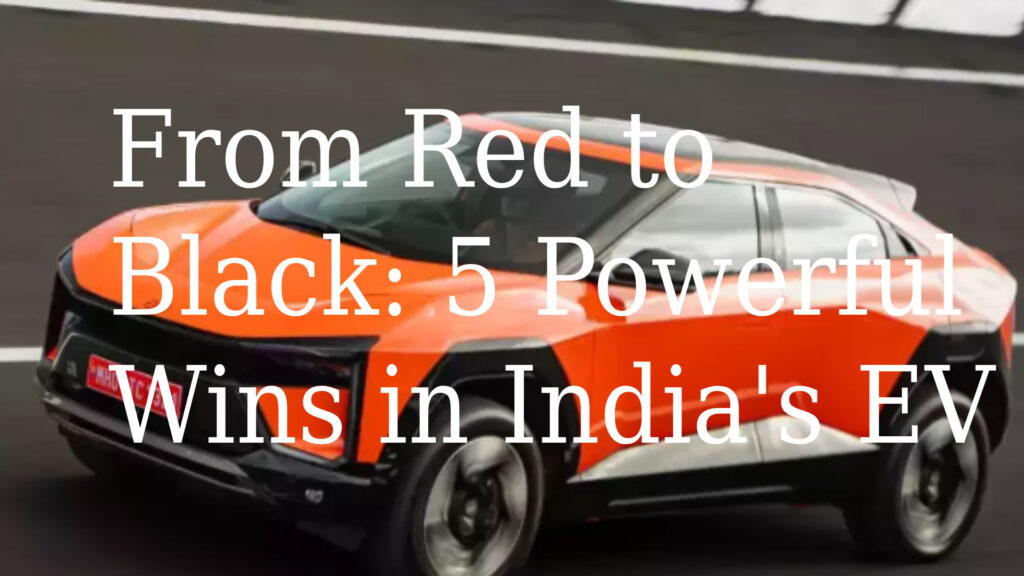From Red to Black: 5 Powerful Wins in India’s EV Profit Race
News From red to black: India’s top automakers see EV business turning around—this headline is no longer a distant dream but an emerging reality for Indian car manufacturers. After years of investment, experimentation, and navigating complex market dynamics, electric vehicle (EV) businesses of major players like Tata Motors, Mahindra & Mahindra (M&M), and Hyundai Motor India are finally moving towards profitability. This shift marks a significant milestone not just for these companies but for the entire Indian automotive sector and the country’s ambitious green mobility goals.
Understanding the Turning Point: The EV Market in India
The electric vehicle market in India has witnessed remarkable growth recently. According to data from the government’s Vahan portal, electric passenger vehicle sales rose by 18% in FY25, reaching 107,645 units. Similarly, two-wheelers demonstrated a 21% sales increase, with 1.14 million units sold during the same period. This surge underlines a growing consumer confidence in electric mobility, driven by various factors ranging from environmental awareness to government incentives.
But growth alone doesn’t guarantee success. What makes From Red to Black the current landscape so promising is the increasing operational profitability of EV divisions within these automakers. The transition from years of losses into positive earnings before interest, taxes, depreciation, and amortization (Ebitda) indicates sustainable business models underneath the growth figures.
Key Players Leading the Charge: Tata Motors, M&M, and Hyundai
Tata Motors, India’s third-largest automaker, From Red to Black reported a positive Ebitda margin of 1.2% in FY25—up from a -7.1% loss just a year prior. This turnaround was attributed to several strategic measures:
- Enhanced localization, helping reduce reliance on expensive imports.
- Aggressive cost control, optimizing manufacturing efficiencies.
- Benefit from government schemes such as the Production-Linked Incentive (PLI) and PM e-Drive.
Shailesh Chandra, Managing Director at Tata Motors Passenger Vehicles Limited, emphasized these points in his shareholder letter, crediting the company’s positive EBITDA status as a rare achievement even globally.
Following Tata Motors is Mahindra & Mahindra (M&M), which entered the EV sector relatively late but has swiftly carved its place. Their unit, Mahindra Electric Automobile Ltd (MEAL), reported Ebitda positivity in its first operational quarter, posting profits without relying on PLI benefits. Their launches like the BE 6 and XUV 9e in Q4 FY25 are already affecting market dynamics by bolstering EV sales.
Hyundai Motor India, a key international player, also confirmed unit-level Ebitda profitability for its flagship electric model, the Creta Electric. While launch-related marketing expenses affect overall margins, the underlying product profitability is a hopeful sign for sustained growth.
Driving Factors Behind Profitability
Multiple dimensions are fueling this turnaround:
- Policy Incentives: Reduced import duties, PLI rewards, and the PM e-Drive scheme significantly lower component costs.
- Localization: Indian production networks are increasingly sourcing raw materials and parts domestically, cutting expenses.
- Consumer Demand Growth: More Indian customers are adopting EVs, creating volume scale important for profitability.
- Technological Advances: Improved battery tech and manufacturing efficiencies reduce unit costs over time.
Shridhar Kallani, a research analyst From Red to Black at Axis Securities, succinctly puts it: “Increasing volumes, government support, and reduced costs together are shifting the economics in favor of profitability.”
Challenges and Skepticism: The Long Road to Parity with ICE Vehicles
Despite these encouraging signs, the EV profitability race in India has its skeptics. Rahul Bharti of Maruti Suzuki, the country’s top conventional automaker, reminded stakeholders that EVs still lag behind internal combustion engine (ICE) vehicles in net profitability. His reasoning is straightforward:
- Extensive government subsidies and tax reductions for EVs imply that without such support, EVs wouldn’t yet be fully profitable.
- The sizeable difference in GST and other incentives points to an uneven playing field in profitability between ICE and EV.
This realism points to a fundamental From Red to Black fact: while EV firms are turning operationally profitable, achieving comparable net profits to ICE vehicles requires sustained volume growth, continued innovation, and perhaps most critically, wider consumer acceptance.
You might also like : Global Automakers
Emerging EV Profitability Stories in the Two-Wheeler Segment
India’s two-wheeler market—a highly competitive and price-sensitive segment—tells a related but distinct profitability story.
Key companies like Bajaj Auto Ltd and Hero MotoCorp expect to break even at the operational level within the next 24 months. Meanwhile, startups and new-age players like Ather Energy and Ola Electric Ltd inch closer to profitability, though some delay is evident due to market slowdowns.
- Ola Electric aims to become Ebitda positive in mid-2025. Founder Bhavish Aggarwal claims the company is close to this milestone despite recent sales cooling.
- Ather Energy improved its Ebitda margin from -42% in FY24 to -23% in FY25, highlighting progress through localization and network expansion.
- Hero MotoCorp expects to achieve profitability in 2-3 years, banking on volume scale, cost reductions, and government incentives.
- Bajaj Auto has already achieved operational break-even in combined e-two and three-wheeler operations.
These companies’ trajectories underscore From Red to Black how scale and cost management remain critical for success, especially in a competitive market where price sensitivity is pronounced.
Factors Underpinning Two-Wheeler EV Profitability
- Cost Reduction Through Localization: Increasing local content in batteries and components reduces import dependence.
- Volume Growth: Expanding customer acceptance fuels sales, pushing revenue upward.
- Government Incentives: PLI schemes and subsidies continue to provide vital financial support.
- Enhanced Infrastructure: Growth in charging infrastructure reduces consumer hesitation and drives demand.
Beyond Profitability: What This Means for India’s EV Future
The emerging profit stories from India’s top automakers signal that EVs are beginning to stand on their own financially, without being entirely dependent on subsidies. This milestone suggests several optimistic trajectories:
- Sustainable Scaling: As companies From Red to Black inch towards profitability, more investments into R&D and manufacturing will follow.
- Market Maturation: Indian EV consumers are gaining trust in EV technology, aiding market expansion.
- Environmental Gains: Profitable EV businesses will accelerate India’s carbon emission reduction goals.
- Employment Opportunities: Growth in EV manufacturing and services could spur job creation.
Yet challenges remain, such as raw material supply chain risks, infrastructure gaps, and competition from ICE vehicles. The recent squeeze in rare earth magnets supply from China, for example, poses risks that Indian automakers must mitigate through innovation and alternate sourcing.
A Pragmatic Yet Promising Path Ahead
India’s EV industry is clearly moving from red to black. The operational profitability of major automakers’ EV businesses is a testament to years of strategic effort, policy support, and consumer momentum. Tata Motors, M&M, Hyundai, and others are leading India’s green revolution with promising financial health, signaling a shift in how the automotive sector operates in the country.
What this means for stakeholders:
- Consumers can expect more competitive EV options as manufacturers optimize costs.
- Investors find promise in Indian automakers’ evolving EV strategies, though cautious optimism remains vital.
- Policy Makers will need to continue tailored incentives and infrastructure support to maintain momentum.
- Industry Players must focus on localization, volume scale, and innovation to sustain profitability and growth.
As the next few years unfold, India’s EV sector is poised for more wins, setting an example for emerging markets worldwide. From operationally profitable to net profit growth and market leadership, the journey is ongoing—but the direction is unmistakably clear.
Key Highlights
- Tata Motors achieved an Ebitda margin of 1.2% in FY25 for its EV business.
- M&M’s EV unit posted EBITDA profitability in its maiden quarter without PLI benefits.
- Hyundai’s Creta EV is profitable at the unit level, excluding launch expenses.
- Major two-wheeler players expect EV profitability within 24 months.
- Volume growth and government incentives remain vital for sustained profitability.
With these trends, India’s EV industry stands on the cusp of a new era—one that combines environmental responsibility with economic viability.
For more check out: Trendlyne













